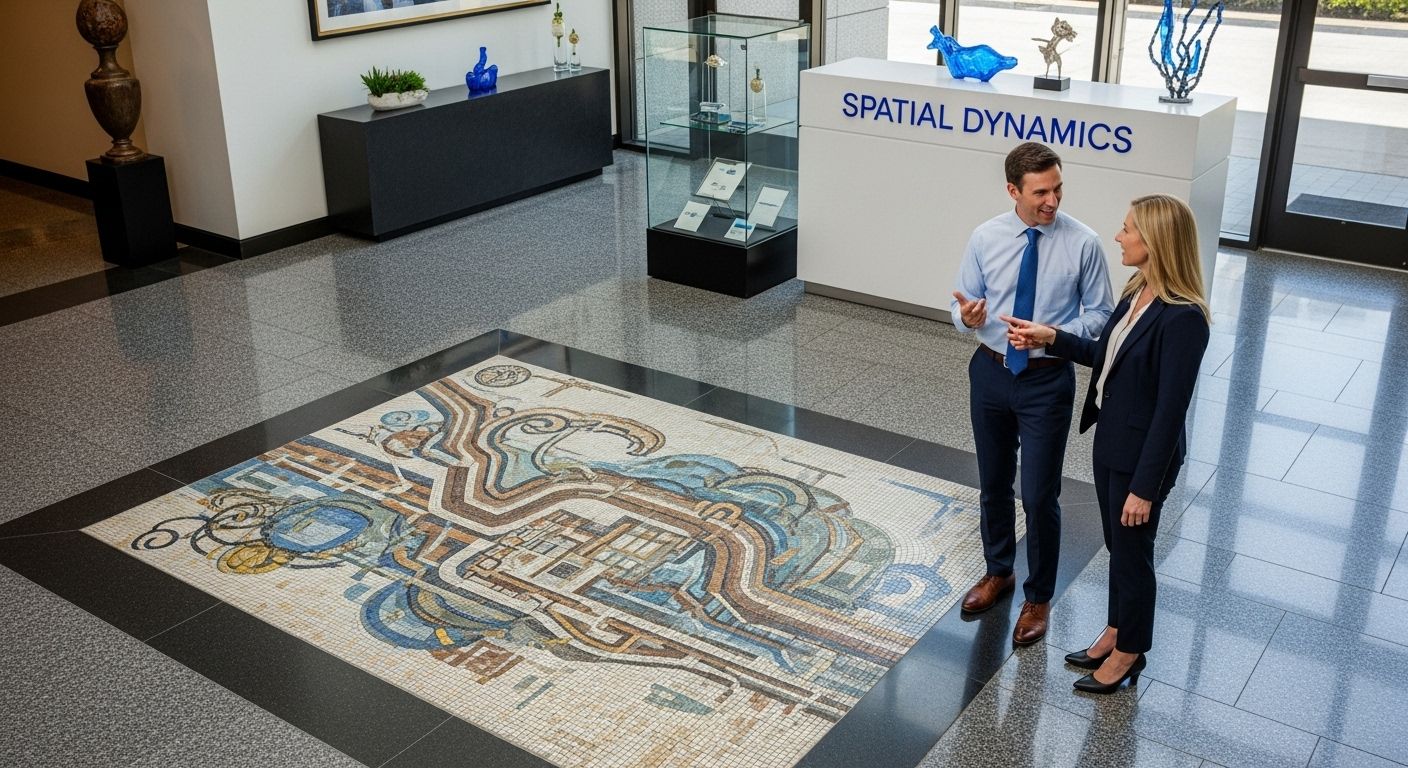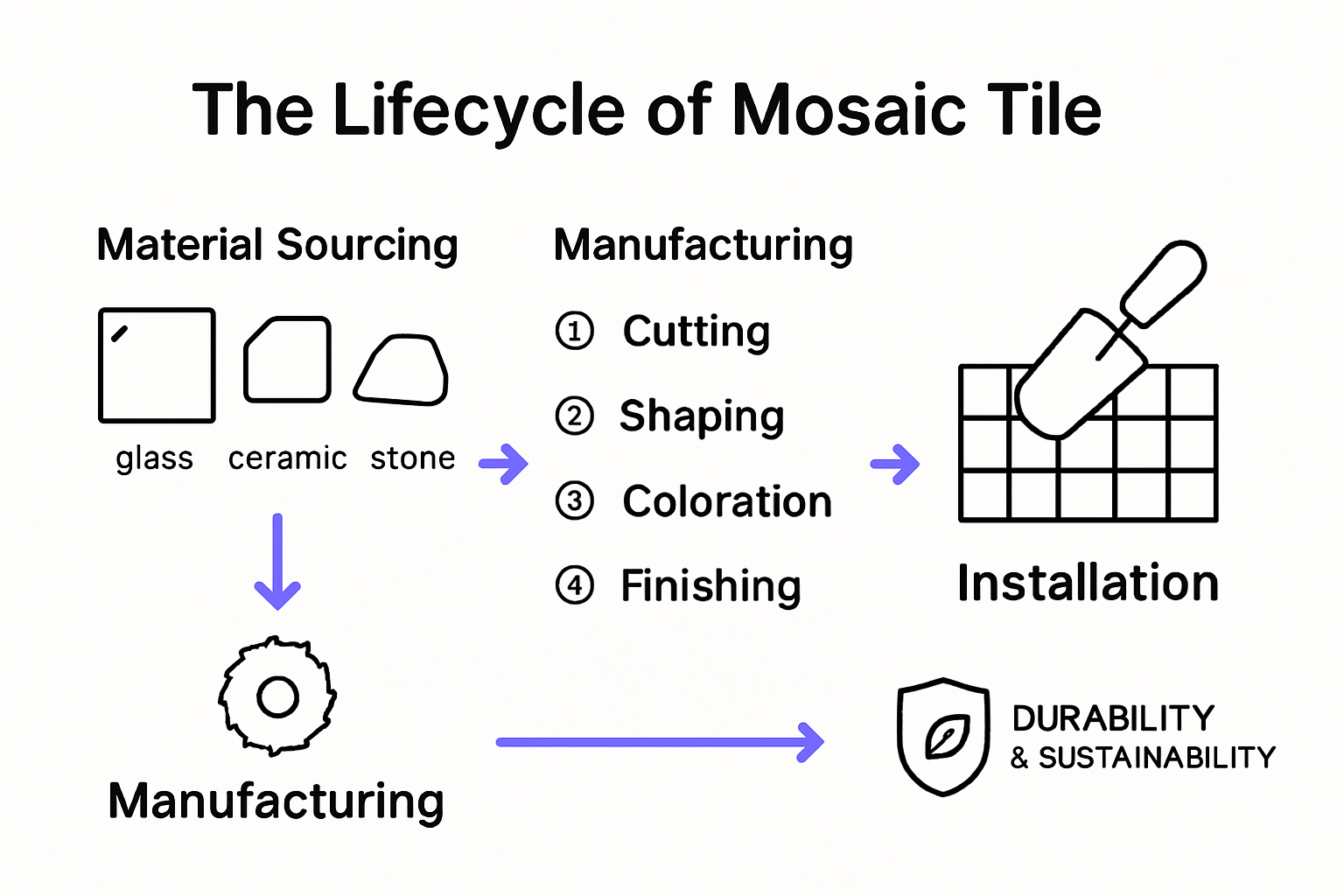What is Mosaic Tile? Understanding Its Beauty and Function
Posted by Mike Belk on Aug 21, 2025

Mosaic tile turns plain spaces into true works of art and packs a serious punch when it comes to style. These tiny tiles can be made from glass, ceramic, stone, metal, or even porcelain. Get this. Mosaic tiles can measure as small as 3/8 inch and up to 2 inches across, giving designers endless freedom to create anything from simple patterns to jaw-dropping murals. What you might not expect is how these little pieces also tell a story about history, sustainability, and technology all woven together in the surfaces you walk on every day.
Table of Contents
- Defining Mosaic Tile: Materials And Styles
- The Importance Of Mosaic Tile In Design
- How Mosaic Tile Is Made And Installed
- Exploring The Versatility Of Mosaic Tile In Spaces
- Sustainability And Trends In Mosaic Tile Usage
Quick Summary
| Takeaway | Explanation |
|---|---|
| Mosaic tile blends materials artfully | Incorporating materials like glass, ceramic, and stone creates unique aesthetics and functionality for diverse designs. |
| Versatile applications in various spaces | Mosaic tiles enhance both residential and commercial environments, from kitchens to public art installations, allowing for creative expression. |
| Mosaic tiles embody cultural narratives | These tiles serve as artistic canvases that communicate stories and heritage through their design, adding depth to spaces. |
| Sustainability is integral to modern design | Current trends focus on eco-friendly practices, such as recycled materials and energy-efficient manufacturing, in tile production. |
| Installation requires technical precision | Successful mosaic tile installation demands careful planning, surface evaluation, and skilled application for visual and functional effectiveness. |
Defining Mosaic Tile: Materials and Styles
Mosaic tile represents an intricate art form that transforms surfaces into stunning visual landscapes through the strategic arrangement of small, carefully selected pieces. These decorative elements combine multiple materials, colors, and shapes to create complex patterns and designs that transcend ordinary surface coverings.
Core Materials in Mosaic Tiling
Mosaic tiles emerge from a diverse range of materials, each offering unique aesthetic and functional characteristics. The primary materials include:
- Glass: Provides translucent, reflective surfaces with vibrant color options
- Ceramic: Offers durability and classic design versatility
- Natural Stone: Delivers organic textures and earthy color variations
- Metal: Creates contemporary, industrial design elements
- Porcelain: Ensures high resistance to wear and moisture
Each material brings distinct properties that enable designers and homeowners to craft personalized visual experiences. Discover creative mosaic tile applications that showcase the incredible potential of these versatile design elements.
Below is a comparison of the primary materials used in mosaic tiles, highlighting their characteristics and typical design applications:
| Material | Key Characteristics | Typical Uses / Aesthetic Impact |
|---|---|---|
| Glass | Translucent, reflective, vibrant colors | Modern, colorful accents, light manipulation |
| Ceramic | Durable, versatile, classic look | Timeless styles, high-traffic areas |
| Natural Stone | Organic textures, earthy color variations | Rustic, natural, luxury installations |
| Metal | Contemporary, industrial, reflective | Edgy, accent pieces, highlight features |
| Porcelain | Highly resistant to wear and moisture | Wet areas, outdoor, heavy-use flooring |
Design Styles and Configurations
Mosaic tile designs range from traditional geometric patterns to abstract contemporary compositions. Traditional styles often draw inspiration from ancient Roman and Byzantine art, featuring intricate symmetrical arrangements. Modern interpretations explore more fluid, experimental configurations that challenge conventional design boundaries.
The size of mosaic tiles typically ranges from 3/8 inch to 2 inches, allowing for extraordinary detail and precision. Designers can create everything from subtle background textures to bold statement pieces that serve as room focal points. The modular nature of mosaic tiles enables complex visual storytelling through strategic piece placement and color selection.
Understanding mosaic tile requires recognizing it as more than just a surface covering. It represents a sophisticated design language that transforms functional spaces into artistic expressions, blending centuries of craftsmanship with contemporary aesthetic sensibilities.
The Importance of Mosaic Tile in Design
Mosaic tiles transcend mere decorative elements, emerging as powerful design tools that communicate artistic vision, cultural heritage, and spatial transformation. Their significance extends far beyond surface aesthetics, representing a sophisticated language of visual storytelling and environmental enhancement.
Artistic Expression and Cultural Narrative
Mosaic tiles serve as miniature canvases that capture complex design philosophies. Designers and architects leverage these intricate pieces to create immersive environments that reflect cultural narratives and personal aesthetic sensibilities. From ancient Roman bathhouses to contemporary urban installations, mosaic tiles communicate stories through carefully curated color palettes and geometric arrangements.
The ability to craft highly personalized design experiences makes mosaic tiles exceptional. Explore innovative mosaic design strategies that demonstrate how these small tiles can dramatically transform spaces.
Functional Design and Spatial Dynamics
Beyond aesthetic appeal, mosaic tiles play critical functional roles in design environments. Their unique properties enable multiple design objectives:
- Visual Depth: Create illusions of spatial complexity
- Light Manipulation: Reflect and refract light to enhance room ambiance
- Surface Durability: Provide resilient, long lasting design solutions
- Textural Variation: Introduce tactile dimensions to surfaces
Architects and interior designers strategically employ mosaic tiles to solve complex design challenges. Their modular nature allows for unprecedented flexibility in addressing spatial constraints while maintaining visual harmony.

The true genius of mosaic tile design lies in its ability to transform mundane surfaces into extraordinary visual experiences. Whether creating subtle background textures or bold artistic statements, these tiles represent a nuanced approach to environmental design that bridges functionality with pure artistic expression.
How Mosaic Tile is Made and Installed
The creation and installation of mosaic tiles represent a sophisticated process combining precision craftsmanship, advanced manufacturing techniques, and artistic vision. This intricate journey transforms raw materials into stunning design elements that breathe life into architectural spaces.
Manufacturing Process
Mosaic tile production involves multiple complex stages that require specialized skills and technological expertise. Depending on the material, manufacturers employ unique techniques to create these miniature design pieces. Glass mosaic tiles, for instance, are typically produced through precise cutting and molding processes that ensure uniformity and aesthetic consistency.
The manufacturing sequence typically involves:
- Material Selection: Choosing high quality base materials with consistent properties
- Cutting and Shaping: Precision cutting techniques to create uniform tile sizes
- Coloration: Adding pigments or applying specialized coating techniques
- Finishing: Applying protective glazes or treatments for durability
Learn about advanced mosaic tile manufacturing techniques that transform raw materials into exquisite design elements.
The table below summarizes the main stages of the mosaic tile manufacturing process and the key considerations for proper installation:
| Step | Stage Description / Key Consideration |
|---|---|
| Material Selection | Choose high quality base materials with consistent properties |
| Cutting and Shaping | Use precision techniques to achieve uniform tile sizes |
| Coloration | Add pigments or apply specialized coatings for color effects |
| Finishing | Apply protective glazes or treatments for durability |
| Substrate Evaluation | Assess surface flatness and structural soundness before installation |
| Adhesive Selection | Choose bonding materials appropriate for the specific tile material |
| Precise Alignment | Maintain consistent tile spacing and geometric patterns during installation |
| Grouting Techniques | Apply complementary grout colors and appropriate methods for seamless finished appearance |
Installation Considerations
Installing mosaic tiles requires meticulous planning and technical expertise. Professionals must consider multiple factors to ensure optimal performance and aesthetic appeal. Surface preparation becomes critical, involving careful evaluation of substrate conditions, moisture levels, and structural integrity.
Key installation considerations include:
- Substrate Evaluation: Assessing surface flatness and structural soundness
- Adhesive Selection: Choosing appropriate bonding materials for specific tile types
- Precise Alignment: Maintaining consistent spacing and geometric patterns
- Grouting Techniques: Selecting complementary grout colors and application methods
The complexity of mosaic tile installation demands not just technical skill but also artistic sensibility. Installers must balance functional requirements with design vision, transforming individual tile pieces into cohesive, visually compelling surfaces that tell a unique spatial narrative.

Exploring the Versatility of Mosaic Tile in Spaces
Mosaic tiles represent extraordinary design chameleons, capable of transforming diverse architectural environments through their remarkable adaptability. Their inherent flexibility allows designers and homeowners to reimagine spaces with unprecedented creative freedom, bridging aesthetic expression and functional requirements across residential and commercial settings.
Residential Design Applications
In residential environments, mosaic tiles emerge as transformative design elements that elevate ordinary spaces into extraordinary experiences. Kitchens, bathrooms, and living areas become canvases for personal artistic expression. Accent walls, backsplashes, and decorative features can be dramatically enhanced through strategic mosaic tile implementation.
Discover innovative kitchen and bathroom design possibilities that showcase the remarkable potential of mosaic tiles in home environments.
Key residential applications include:
- Kitchen Backsplashes: Creating visual focal points behind cooking areas
- Bathroom Accent Walls: Adding texture and visual depth to shower spaces
- Fireplace Surrounds: Introducing elegant decorative elements
- Flooring Borders: Defining spatial transitions with intricate designs
Commercial and Public Space Transformations
Beyond residential contexts, mosaic tiles demonstrate extraordinary versatility in commercial and public environments. Architects and designers leverage these dynamic elements to craft immersive experiences in spaces ranging from hospitality venues to cultural institutions.
Commercial spaces benefit from mosaic tiles through:
- Lobby Installations: Creating memorable architectural statements
- Restaurant Design: Developing unique atmospheric environments
- Hospitality Accent Areas: Introducing sophisticated visual narratives
- Healthcare Facility Enhancements: Providing calming, aesthetic treatments
The true power of mosaic tiles lies in their ability to transcend traditional design boundaries. Whether creating subtle background textures or bold artistic statements, these versatile design elements offer unprecedented potential for spatial transformation across multiple architectural contexts.
Sustainability and Trends in Mosaic Tile Usage
The mosaic tile industry is experiencing a profound transformation, driven by evolving environmental consciousness, technological innovations, and changing design aesthetics. Contemporary trends reflect a harmonious blend of sustainability, functionality, and artistic expression that reimagines how designers and consumers approach tile selection and implementation.
Environmental Considerations
Sustainability has become a cornerstone of modern mosaic tile production. Manufacturers are increasingly adopting eco-friendly practices that minimize environmental impact while maintaining exceptional product quality. Recycled materials and responsible manufacturing processes are now integral to tile development, reflecting a global commitment to reducing carbon footprints.
Explore sustainable natural stone mosaic trends that demonstrate innovative approaches to environmentally conscious design.
Key sustainability strategies include:
- Recycled Material Integration: Incorporating post-consumer waste into tile production
- Energy Efficient Manufacturing: Reducing carbon emissions during tile creation
- Water Conservation: Implementing advanced water recycling techniques
- Local Material Sourcing: Minimizing transportation environmental impacts
Design and Technology Convergence
Emerging trends in mosaic tile usage reflect a dynamic intersection of design innovation and technological advancement. Advanced manufacturing techniques now enable unprecedented levels of customization, allowing designers to create intricate patterns and unique visual experiences that were previously impossible.
Contemporary mosaic tile trends demonstrate:
- Digital Printing Technologies: Creating hyper-realistic design reproductions
- Smart Surface Integration: Developing tiles with embedded technological capabilities
- Modular Design Flexibility: Enabling complex, adaptable architectural solutions
- Multifunctional Surface Treatments: Developing tiles with enhanced performance characteristics
The evolution of mosaic tiles represents more than aesthetic transformation. These innovative design elements are becoming sophisticated architectural solutions that balance beauty, functionality, and environmental responsibility, signaling a new era of conscious material selection and design thinking.
Bring the Beauty and Function of Mosaic Tile Into Your Space
Are you inspired by the timeless artistry and practical versatility of mosaic tile solutions? If you find yourself overwhelmed by countless choices or unsure where to begin, it is common to feel challenged when searching for the right blend of durability, visual impact, and style. The article highlighted the magic of glass, ceramic, porcelain, and natural stone mosaics in transforming residential and commercial areas, but translating these design possibilities into real-life spaces can be daunting.
At BELK Tile, you will find a curated selection of premium mosaic tiles crafted for lasting beauty and modern functionality. Whether your goal is to create an inviting kitchen backsplash, a show-stopping bathroom accent, or a vibrant poolside design, our collections are organized to make your shopping experience seamless. Experience how we simplify the process of finding the perfect tile with detailed product information, powerful filtering, and expert inspiration. Visit BELK Tile’s home page today and take the next step toward turning your mosaic tile vision into reality. Do not wait to transform your project—start browsing now and bring extraordinary design into your everyday life.
Frequently Asked Questions
What materials are commonly used in mosaic tiles?
Mosaic tiles are typically made from a variety of materials including glass, ceramic, natural stone, metal, and porcelain. Each material offers unique aesthetic qualities and functional benefits, such as durability and design versatility.
How do I install mosaic tiles?
Installing mosaic tiles requires careful planning, including substrate evaluation, adhesive selection, precise alignment, and grouting techniques. Proper surface preparation is essential to ensure durability and aesthetic appeal in the final installation.
What design styles can mosaic tiles be used in?
Mosaic tiles can be utilized in a range of design styles, from traditional geometric patterns inspired by historical art to modern abstract configurations that challenge conventional design norms. Their size and modular nature allow for highly detailed and personalized designs.
How do mosaic tiles contribute to sustainability in design?
Mosaic tiles contribute to sustainability through the use of recycled materials and eco-friendly manufacturing practices. Many manufacturers are adopting energy-efficient processes and local material sourcing, making mosaic tiles an environmentally conscious choice for modern design.



